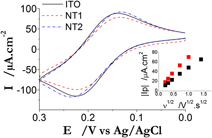Article contents
Transparent electrodes made from carbon nanotube polyelectrolytes and application to acidic environments
Published online by Cambridge University Press: 23 June 2015
Abstract

Carbon nanotube (CNT)-based transparent conducting films (TCFs) have been prepared by filtration of (i) surfactant-based aqueous dispersions and (ii) organic solutions obtained by reductive dissolution of an alkali metal salt of polyelectrolyte nanotubes. Starting from the same source of nanotubes, it is shown that films obtained by the reductive dissolution route present up to one order of magnitude better conductivity for the same transmittance. Light scattering experiments show that the average CNT length is much larger for the reductive dissolution-based organic solutions than for the sonication aided aqueous dispersions. Values of surface resistivity of 200 ohm per square have been obtained for 80% transmittance. Additionally, it is shown that the CNT-based TCFs are undistinguishable from indium tin oxide (ITO) as electrodes in regular environments, whereas they perform efficiently in acidic environments where ITO fails.
- Type
- Invited Feature Paper
- Information
- Copyright
- Copyright © Materials Research Society 2015
References
REFERENCES
- 10
- Cited by


